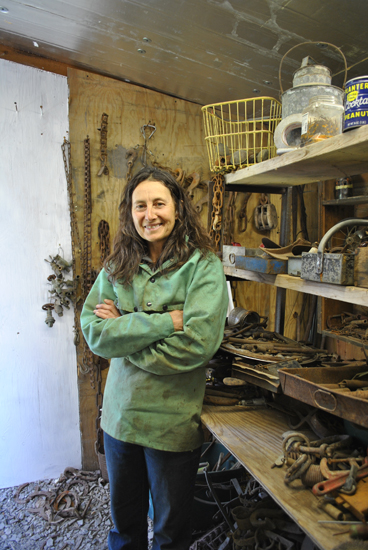 To most people a pile of discarded farm implements, hand tools and metal hardware too deteriorated for its intended use is merely a heap of junk.
To most people a pile of discarded farm implements, hand tools and metal hardware too deteriorated for its intended use is merely a heap of junk.
To 56-year-old Jenny Horstman of Fort Ann, New York, rusted door knobs, corroded springs, abandoned shovel handles and cast off pieces of metal have the potential to become “body parts” within her life-size metal sculptures.
“Each of these pieces were really important once,” she explains, “It’s really powerful to create something that is beautiful and alive out of something someone else would throw away.”
And alive they are. It’s rather eerie looking through the camera lens to photograph a moose’s face, constructed of bolt cutters and door knobs, to “feel” his eyes staring back at you.
But, that’s what talented artists do. They bring life to inanimate objects.
Born into a family of artists, Horstman grew up drawing, painting and admiring her grandfather’s intricate wood carvings.
“I tried wood carving, but cut myself too many times and had to give it up,” she laughs.
Mesmerized by the wooden tools and spare parts in her grandfather’s tool shed, she took an interest in sculpture.
She began welding when she was 15 and enrolled in the local BOCES (Board of Cooperative Education Services) Welding As Sculpture class. A year later she began working in the tool room at Mullen Iron Works in Glens Falls, New York.
“I always thought they (the tools) had such interesting shapes,” she adds.
After graduation from high school Horstman was accepted into the San Francisco Institute of Fine Arts program in California and moved west with a friend. When she saw the campus for the first time, she was too intimidated to enroll in classes. “I had never seen a place like that,” she reminisced.
Instead she went to work as a welder.
“I was given a truck with a welding machine and sent on jobs throughout San Francisco,” Horstman says.
Two years later, she returned home and joined the Plumbers & Pipefitters Local 773 Union. She worked on nuclear power plants, paper mills and other projects across New England.
In 1993, welding took her back to the west coast, Alaska specifically, where she worked on “White Alice” Telecommunication Sites for the United States Air Force. Over the course of her career Horstman earned more than 70 welding certifications.
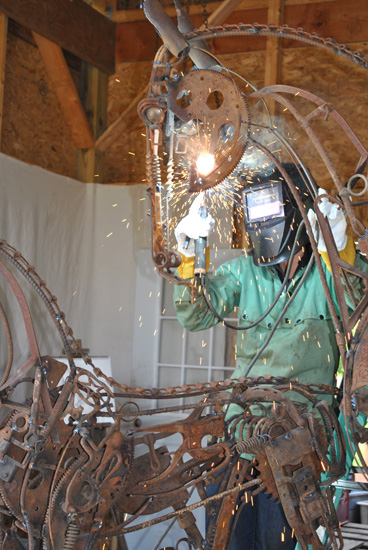 “A lot of times you had to take five welding tests just to get on a job,” she explains, “the companies had to be sure you would be capable of making the difficult welds.”
“A lot of times you had to take five welding tests just to get on a job,” she explains, “the companies had to be sure you would be capable of making the difficult welds.”
Eventually, Horstman came to the realization that while she was an exceptional welder, her true calling in life was art.
“Intuitively, I knew it was time for me to do my art,” she says.
Leaving behind a home and a husband, Horstman returned to New York’s Adirondack Mountains where she bought an old farmhouse and, with the help of neighbors, built a studio.
Inside her three-sided art studio is where all of the parts and pieces collected from scarp yards or dropped off by friends comes to life. She begins with sketching the project in great detail, even if certain aspects of the sketch will never make it into the sculpture.
“I draw in the skeleton even though there isn’t a skeleton in the sculpture because it helps me know where the point of shoulder, hip, etc. should be,” she says.
Then she looks for items that “fit” into the sculpture.
“I have an area I want to work with and I just walk around and hold up the piece I am working with. If the piece disappears into the sculpture, that’s where it goes,” she explains, “if I can see the piece then it doesn’t go there.”
No item is cast off as insignificant. Horstman has used the beater from an old manure spreader, tractor seats, horse shoes, bits, an old pistol and more. Though she has plenty of unique pieces to choose from, her favorite are springs.
Each spring features a different tension and a different set of lines that act much like cross-hatching. “Springs can add so much tension to a sculpture,” she adds, “I can weld a washer into the sculpture and hook a spring into it and then hook the other end into another washer and you can feel that tension.”
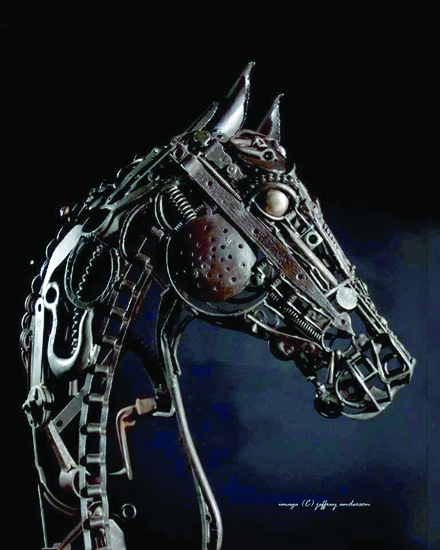 Ultimately, she doesn’t want the sculpture to be about the individual objects, instead, she strives to achieve a sculpture that balances positive and negative space to create a final piece that is light and airy and looks as if the subject is moving.
Ultimately, she doesn’t want the sculpture to be about the individual objects, instead, she strives to achieve a sculpture that balances positive and negative space to create a final piece that is light and airy and looks as if the subject is moving.
So far, Horstman says each of her pieces have been “easy”.
“I have never not had something come out right. I have never had to cut off a shoulder and reweld,” she says, “each piece is like a magnet, it just goes where it’s meant to be.”
Horses are her favorite subject.
Her current work in progress is a mare and foal. “Horses have grace and nobility, beauty and pride,” she says. Past projects have included the headless horseman and a tribute to 2003 Kentucky Derby and Preakness winner Funny Cide among many others. Her “Starting Gate” features horses loaded into a racing gate anxiously awaiting the clamor of the starting bell. This piece won sixth place in the World Equine Expressions Art Contest.
Her love of horses started as a young child. She never competed, but rode as often as she could at the local stable. As an adult she spent many years away from horses, but with the purchase of an Off The Track Thoroughbred named, Roan Rooster, she has started riding again.
“Learning to jump has increased my awareness of where his legs are in motion and when he is round in the bit I can feel which muscles are engaged,” she explains. The everyday brushing and touching has heightened her awareness of the smallest details.”
And when she needs a break from the hard work, he pokes his head in the studio window for a quick visit and an apple.
While horses take center stage, Horstman has also sculpted moose, mules, cows, dogs and other animals. Her favorite project thus far has been “A Cow Named Elsie.”
For three weeks, she visited a neighbor’s farm to sketch and learn the animal’s anatomy.
“Cows are working animals and they have conformation strengths and weaknesses,” she explains, “when I got done (with the sculpture) I really felt like she had a full udder and her back hurt from the weight.”
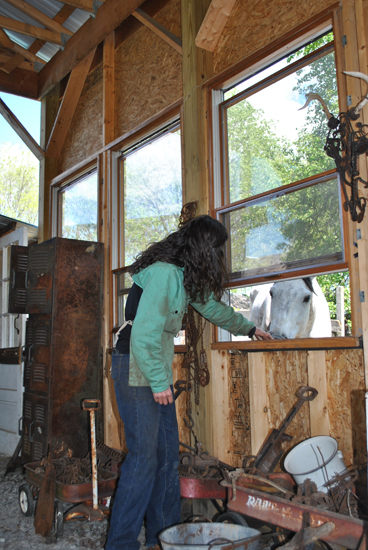 Working for herself rather than on commission gives Horstman the freedom to follow her creative whim. Which is how the “Canal Tow Mule” came to be.
Working for herself rather than on commission gives Horstman the freedom to follow her creative whim. Which is how the “Canal Tow Mule” came to be.
“Everything is so fast and life moves so fast that I felt there should be a mule near the Champlain Canal Locks (the canal running from Waterford, New York to Lake Champlain.), to remind us of the slower pace life used to be,” she explains.
She received a grant from the Lower Adirondack Regional Arts Council for her work on the piece and once finished it was purchased by the Lakes of Locks Passage purchased the mule for permanent display.
“I like selling public pieces because then people can continue to enjoy them,” she says.
Her sculptures take several months to a year to complete. Once a piece is finished it is offered for sale through Tilting Art Windmills Gallery. Most of her work is purchased by individuals for their private collections although local companies like the Lake George Steamboat Company have also purchased pieces.
Once a year she opens her studio for folks to see what she’s working on as well as having the opportunity to purchase hand drawn/painted cards and smaller pieces.
“I spent many years unhappy as a welder, even though I was really good at it. Now, I love what I do,” she says.
Her current work in progress is a mare and foal. “Horses have grace and nobility, beauty and pride,” she says. Past projects have included the headless horseman and a tribute to 2003 Kentucky Derby and Preakness winner Funny Cide among many others. Her “Starting Gate” features horses loaded into a racing gate anxiously awaiting the clamor of the starting bell. This piece won sixth place in the World Equine Expressions Art Contest.
Horstman’s love of horses started as a young child. She never competed, but rode as often as she could at the local stable. As an adult she spent many years away from horses, but with the purchase of an Off The Track Thoroughbred named, Roan Rooster, she has started riding again.
“Learning to jump has increased my awareness of where his legs are in motion and when he is round in the bit I can feel which muscles are engaged,” she explains. The everyday brushing and touching has heightened her awareness of the smallest details. And when she needs a break from the hard work, he pokes his head in the studio window for a quick visit and an apple.
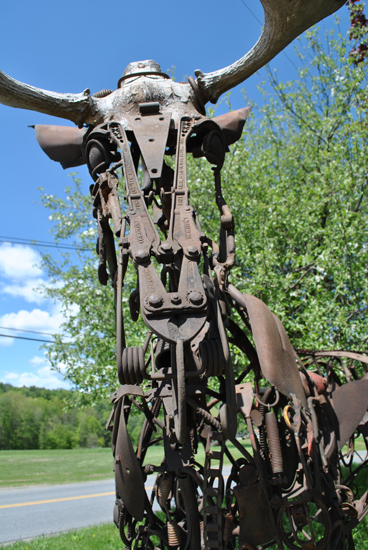 While horses take center stage, Horstman has also sculpted moose, mules, cows, dogs and other animals. Her favorite project thus far has been “A Cow Named Elsie.”
While horses take center stage, Horstman has also sculpted moose, mules, cows, dogs and other animals. Her favorite project thus far has been “A Cow Named Elsie.”
For three weeks, she visited a neighbor’s farm to sketch and learn the animal’s anatomy.
“Cows are working animals and they have conformation strengths and weaknesses,” she explains, “when I got done (with the sculpture) I really felt like she had a full udder and her back hurt from the weight.”
Working for herself rather than on commission gives Horstman the freedom to follow her creative whim. Which is how the “Canal Tow Mule” came to be.
“Everything is so fast and life moves so fast that I felt there should be a mule near the Champlain Canal Locks (the canal running from Waterford, New York to Lake Champlain.), to remind us of the slower pace life used to be,” she explains.
Horstman received a grant from the Lower Adirondack Regional Arts Council for her work on the piece. Once finished, the Lakes of Locks Passage purchased the mule for permanent display.
“I like selling public pieces because then people can continue to enjoy them,” she says.
Her sculptures take several months to a year to complete. Once a piece is finished it is offered for sale through Tilting Art Windmills Gallery. Most of her work is purchased by individuals for their private collections although local companies like the Lake George Steamboat Company have also purchased pieces.
Private collectors Frank Andrews and Lesa Smith own two of Jenny’s sculptures. The first sculpture they purchased is “Sitting Dog,” a larger than life size dog.
“Jenny explained to us that it is a tribute to war dogs,” Frank says.
In December 2013, they purchased a life-size horse that stands in their backyard.
“We look at the horse every day and it’s almost like it’s alive, almost like it moves,” he adds, “she has the ability to take a whole box of rusty tools and stick them together to make something soft and fluid.”
Once a year she opens her studio for folks to see what she’s working on as well as have the opportunity to purchase hand drawn/painted cards and smaller pieces.
“I spent many years unhappy as a welder, even though I was really good at it. Now, I love what I do,” she says.



You must be logged in to post a comment Login